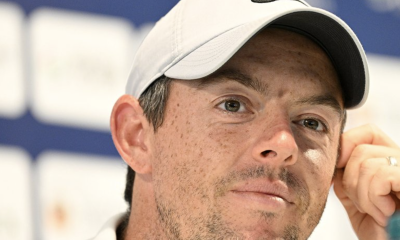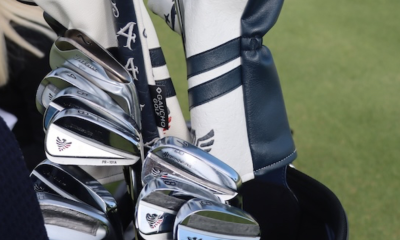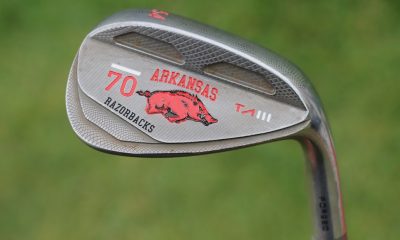Opinion & Analysis
Champagne Time: On the 50th anniversary of the death of Tony Lema

One afternoon a lifetime ago, in a scraggly bit of park between a suburban New York commuter railroad station and the dire Bronx River, a skinny little young teen was working on his short game. With his trusty 9-iron, the kid hit pitches from target to target: tree, bare spot, piece of litter. And then Masters champion Doug Ford came along, asked the kid what he was aiming at — “That tree there?” — and with the kid’s club stiffed it.
I tell this story to explain, in sentimental part, why I recently tracked down a copy of Ford’s 1963 Wedge Book. (Let me also add that Doug Ford did have local connections, which makes his appearance there in a patch of southern Westchester train-station scrub less golfus ex machina than you might have thought it.) That hard-practicing kid’s once stellar short game has gotten maddeningly erratic, this near-half-century later, and in looking around for guidance I discovered Ford’s little volume, previously unknown to me. It contains advice that is still very helpful — and it also contains, in Julius Boros’s Preface, a sentence that left me nearly as open-mouthed with wonderment as Ford’s no-practice-swing bullseye left my younger self. Boros, himself a three-time major champion, mentions having worked his way up with Ford on the post-war pro circuit “amid some pretty fine company — Jackie Burke, Ted Kroll, Tommy Bolt and Jerry Barber, to name a few.” And then Boros, writing in September 1963, adds this:
“Doug Ford and I both feel that the current crop of young golfers, including Arnold Palmer, Gary Player, Jack Nicklaus, and Tony Lema, is the best to come up since that group a decade ago.”
The King, the Black Knight, the Golden Bear — of course the Big Three, all still happily with us, did go on to be “the best” of that golfing generation (and then some). But that there might have been a Big Fourth? What about the last-named member of Boros’s then-young foursome?
Smooth swing
Well, I knew that Tony Lema had a nickname, too — although “Champagne Tony” is definitely under-dressed for keeping company with the Big Three’s era-bestriding monikers. And I also knew that Lema’s nickname accurately reflected his life-of-the-party lifestyle. (As today’s parlance would have it, he owned his choices: “I have never denied myself a drink or a good dinner or a party while I am out on Tour.”) What I had not known, prior to turning from Boros to Wikipedia and beyond, was the extent to which Tony Lema’s tragically-short career had justified lofty expectations, right up to Big Four-dom.
The biographical basics I discovered are as follows. Anthony David Lema was born in Oakland in 1934, five years after Palmer, a year before Player, six before Nicklaus. Raised on the wrong side of the tracks, he learned golf at a local muni, becoming good enough to win the Oakland City championship at 18. He served overseas in the Marine Corps, then came home to work at the San Francisco Golf Club and a Nevada nine-holer. By 1957-58, Lema was out on the pro circuit, with financial backing from Eddie Lowery, otherwise known to golfing history as Francis Ouimet’s 10-year-old caddy at the 1913 U.S. Open.
With, as Peter Alliss described it, “an elegant swing of rare beauty” — so sweet and smooth “you could pour [it] on popcorn,” in another admirer’s words — Lema enjoyed some early pro success. (Video of that swing, with commentary by Hale Irwin, is available on YouTube.)
Lean years followed, but then came the breakthrough. He won three times in the fall of 1962, once in 1963, and in 1964 went on a streak that saw him win the Crosby at Pebble in January, the Thunderbird Classic and the Buick and Cleveland Opens in June, and the Open Championship (by five strokes over Nicklaus in second) at St. Andrews in July. (Lema chronicled his early tour experiences in Golfer’s Gold, which George Plimpton applauded as showing “considerable flair for the written word.”)
A couple more titles followed in 1965, and a final victory in May of 1966. Add a second-place finish at the ’63 Masters; a 9-1-1 record in two Ryder Cup appearances (’63 and ’65 — the best record of any competitor with at least two appearances); 50 percent top-10 finishes from ’63 through ’66; and a win over Palmer, Ken Venturi, and Bobby Nichols at the 1964 World Series of Golf (taking home $50K, which was then the game’s largest purse), and Lema’s career certainly seemed to be tracking toward Hall of Fame status.
Instead, too-soon his time ran out: on July 24, 1966, after his final round in the PGA Championship at Firestone Country Club in Akron, Lema headed with his pregnant wife for Chicago to play the next day in an exhibition in Crete, Illinois. Less than a mile from arrival, the twin-engine charter crashed … on a golf course, just short of the green of a par three.
As veteran N.Y. Times journalist Dave Anderson was to note, Tony Lema’s death “saddened even casual followers of golf because of his appeal.”
And his appeal was considerable
Tall, handsome, and personable, Champagne Tony lived extra-large — with “effervescence,” was Anderson’s memorable choice of adjective, although he could well have simply chosen “extravagance.” Lema boasted that although he finished second in tournament earnings in 1965, he finished “first in spendings.” (He took home just over a hundred thousand in prize money that year.)
With an outgoing style “that let others in on the enjoyment of his victories,” Lema became almost as popular as his good friend, the game’s charismatic King, achieving the type of crossover celebrity not previously enjoyed by professional golfers in the pre-Palmer era. So the nickname Champagne Tony was made to order for such a “colorful and endearing character.” He had been christened with it after his first big win at the Orange County Open in the fall of 1962. An excited Lema, hungering for a validating title at long last, promised the press corps after 54 holes that “if I win this thing, guys, it’ll be champagne all around, not beers, tomorrow.” And next day, sure enough, the playoff victory was Lema’s and the bubbly went to the writers — although, as he later admitted, “all the sportswriters there couldn’t have drunk as much as I did that night.”
(But at least that time he waited: an earlier, unofficial win had come after a playoff for which he’d prepared with three quick post-round highballs, thinking his workday already done. On the other hand, he would later go ahead and tempt fate by serving up the bubbly at the halfway point of his victorious ’64 Open Championship, when he held a two-stroke lead over the field.)
In short, whether taking driver out a 12th-floor hotel window during a late-night party, or exchanging club for baton during a TV appearance at the helm of Lawrence Welk’s “Champagne Music Makers,” Champagne Tony, off the course and away from the game, was always the life of the party.
Memorials
Lema’s friends and fellow pros kept that party going in his honor for many years. Beginning a year or two after his death, and continuing until 1980, the Tony Lema Memorial attracted top names in the worlds of sports and entertainment, as well as many of golf’s greats — 50 celebs, 50 pros, 100 amateurs. The one-day invitational, with gala dinner the night before, was held on Marco Island, Florida, at what was then the Marco Island Country Club, where Lema had been the first, albeit unofficial, club pro. According to local reporter Tom Rife, writing in 2006 in memory of the Memorial, “Not before, and not since has Southwest Florida known anything like it.”
Nor, as it turned out, had that golf-crazy youngster mentioned earlier known anything like the Marco Island course, when he and his father came to tee it up there in the spring of 1969. My scorecards from their two rounds are, I suppose, my most-prized golf mementoes. As the scores themselves attest (125 and 126, 118 and 121), neither I nor my father, whose own recent introduction to the game had opened the door to my taking it up, had ever played such an overwhelmingly challenging course. Indeed, handling the cards, a memory annotates the rounds: so many balls lost in the seemingly-ever-present water we had to suspend play to ride in to get more!
So that, anyway, is why one golfer, on this July 24th, celebrated the half-century anniversary of Tony Lema’s death with thoughts not only about what might have been, in Champagne Tony’s case, but also with reflections on what has been, in the lifetime of that kid who, amazingly now almost 50 years a golfer, is still trying to better his short game.
- LIKE60
- LEGIT5
- WOW5
- LOL0
- IDHT0
- FLOP0
- OB0
- SHANK0
19th Hole
Vincenzi’s 2024 PGA Championship betting preview: Rising star ready to join the immortals at Valhalla

The second major of the 2024 season is upon us as the world’s best players will tee it up this week at Valhalla Golf Club in Louisville, Kentucky to compete for the Wanamaker Trophy.
The last time we saw Valhalla host a major championship, Rory McIlroy fended off Phil Mickelson, Henrik Stenson, Rickie Fowler and the creeping darkness that was descending upon the golf course. The Northern Irishman had the golf world in the palm of his hand, joining only Tiger Woods and Jack Nicklaus as players who’d won four major championships by the time they were 25 years old.
Valhalla is named after the great hall described in Norse mythology where the souls of Vikings feasted and celebrated with the Gods. The course is a Jack Nicklaus-design that has ranked among Golf Digest’s “America’s 100 Greatest Courses” for three decades.
Valhalla Golf Club is a par-71 measuring 7,542 yards with Zoysia fairways and Bentgrass greens. The course has rolling hills and dangerous streams scattered throughout and the signature 13th hole is picturesque with limestone and unique bunkering protecting the green. The 2024 PGA Championship will mark the fourth time Valhalla has hosted the event.
The field this week will consist of 156 players, including 16 PGA Champions and 33 Major Champions.
Past Winners of the PGA Championship
- 2023: Brooks Koepka (-9) Oak Hill
- 2022: Justin Thomas (-5) Southern Hills
- 2021: Phil Mickelson (-6) Kiawah Island
- 2020: Collin Morikawa (-13) TPC Harding Park
- 2019: Brooks Koepka (-8) Bethpage Black
- 2018: Brooks Koepka (-16) Bellerive
- 2017: Justin Thomas (-8) Quail Hollow
- 2016: Jimmy Walker (-14) Baltusrol
- 2015: Jason Day (-20) Whistling Straits
- 2014: Rory McIlroy (-16) Valhalla
In this article and going forward, I’ll be using the Rabbit Hole by Betsperts Golf data engine to develop my custom model. If you want to build your own model or check out all of the detailed stats, you can sign up using promo code: MATTVIN for 25% off any subscription package (yearly is best value).
Key Stats For Valhalla
Let’s take a look at five key metrics for Oak Hill to determine which golfers boast top marks in each category over their past 24 rounds.
1. Strokes Gained: Approach
Valhalla will play as a true all-around test of golf for the world’s best. Of course, it will take strong approach play to win a major championship.
Strokes Gained: Approach Over Past 24 Rounds
- Shane Lowry (+1.25)
- Scottie Scheffler (+1.09)
- Jordan Smith (+1.05)
- Tom Hoge (+.96)
- Corey Conners (+.94)
2. Strokes Gained: Off the Tee
Valhalla will play long and the rough will be penal. Players who are incredibly short off the tee and/or have a hard time hitting fairways will be all but eliminated from contention this week at the PGA Championship.
Strokes Gained: Off the Tee Over Past 24 Rounds:
- Bryson DeChambeau (+1.47)
- Scottie Scheffler (+1.11)
- Keith Mitchell (+.90)
- Alejandro Tosti (+.89)
- Ludvig Aberg (+.82)
Strokes Gained: Total on Nickalus Designs
Valhalla is a classic Nicklaus Design. Players who play well at Nicklaus designs should have an advantage coming into this major championship.
Strokes Gained: Total on Nicklaus Designs over past 36 rounds:
- Jon Rahm (+2.56)
- Scottie Scheffler (+2.48)
- Patrick Cantlay (+2.35)
- Collin Morikawa (+1.79)
- Shane Lowry (+1.57)
Strokes Gained: Tee to Green on Very Long Courses
Valhalla is going to play extremely long this week. Players who have had success playing very long golf courses should be better equipped to handle the conditions of this major championship.
Strokes Gained: Total on Very Long Courses Over Past 24 Rounds:
- Scottie Scheffler (+2.44)
- Rory McIlroy (+2.24)
- Will Zalatoris (+1.78)
- Viktor Hovland (+1.69)
- Xander Schauffele (+1.60)
Strokes Gained: Total in Major Championships
One factor that tends to play a large role in deciding major championships is which players have played well in previous majors leading up to the event.
Strokes Gained: Total in Major Championships over past 20 rounds:
- Scottie Scheffler (+3.14)
- Will Zalatoris (+2.64)
- Rory McIlroy (+2.49)
- Xander Schauffele (+2.48)
- Tommy Fleetwood (2.09)
Strokes Gained: Putting on Bentgrass Greens
Valhalla features pure Bentgrass putting surfaces. Players who are comfortable putting on this surface will have an advantage on the greens.
Strokes Gained: Putting on Bentgrass Greens over Past 24 Rounds:
- Ludvig Aberg (+1.12)
- Denny McCarthy (+1.08)
- Matt Fitzpatrick (+0.99)
- Justin Rose (+0.93)
- J.T. Poston (0.87)
Strokes Gained: Total on Zoysia Fairways
Valhalla features Zoysia fairways. Players who are comfortable playing on this surface will have an advantage on the field.
Strokes Gained: Total on Zoysia Fairways over past 36 rounds:
- Justin Thomas (+1.53)
- Will Zalatoris (+1.47)
- Xander Schauffele (+1.40)
- Brooks Koepka (+1.35)
- Rory McIlroy (+1.23)
2024 PGA Championship Model Rankings
Below, I’ve compiled overall model rankings using a combination of the key statistical categories previously discussed — SG: Approach (25%), SG: Off the Tee (22%), SG: T2G on Very Long Courses (12%), SG: Putting on Bentgrass (+12%), SG: Total on Nicklaus Designs (12%). SG: Total on Zoysia Fairways (8%), and SG: Total in Major Championships (8%).
- Brooks Koepka
- Xander Schauffele
- Rory McIlroy
- Scottie Scheffler
- Bryson DeChambeau
- Shane Lowry
- Alex Noren
- Will Zalatoris
- Cameron Young
- Keith Mitchell
- Hideki Matsuyama
- Billy Horschel
- Patrick Cantlay
- Viktor Hovland
- Adam Schenk
- Chris Kirk
- Sahith Theegala
- Min Woo Lee
- Joaquin Niemann
- Justin Thomas
2024 PGA Championship Picks
Ludvig Aberg +1800 (BetMGM)
At The Masters, Ludvig Aberg announced to the golf world that he’s no longer an “up and coming” player. He’s one of the best players in the game of golf, regardless of experience.
Augusta National gave Aberg some necessary scar tissue and showed him what being in contention at a major championship felt like down the stretch. Unsurprisingly, he made a costly mistake, hitting it in the water left of the 11th hole, but showed his resilience by immediately bouncing back. He went on to birdie two of his next three holes and finished in solo second by three shots. With the type of demeanor that remains cool in pressure situations, I believe Ludvig has the right mental game to win a major at this point in his career.
Aberg has not finished outside of the top-25 in his past eight starts, which includes two runner-up finishes at both a “Signature Event” and a major championship. The 24-year-old is absolutely dominant with his driver, which will give him a major advantage this week. In the field he ranks, in Strokes Gained: Off the Tee, and has gained strokes in the category in each of his past ten starts. Aberg is already one of the best drivers of the golf ball on the planet.
In Norse mythology, Valhalla is the great hall where the souls of Vikings feasted and celebrated with the Gods. The Swedes, who are of Old Norse origin, were the last of the three Scandinavian Kingdoms to abandon the Old Norse Gods. A Swede played a major role in the 2014 PGA Championship at Valhalla, and I believe another, Ludvig Aberg, will be the one to conquer Valhalla in 2024.
Bryson DeChambeau +2800 (BetMGM)
Bryson DeChambeau is one of the few players in the world that I believe has the game to go blow-for-blow with Scottie Scheffler. Although he isn’t as consistent as Scheffler, when he’s at his best, Bryson has the talent to beat him.
At The Masters, DeChambeau put forth a valiant effort at a golf course that simply does not suit his game. Valhalla, on the other hand, is a course that should be perfect for the 30-year-old. His ability to overpower a golf course with his driver will be a serious weapon this week.
Bryson has had some success at Jack Nicklaus designs throughout his career as he won the Memorial at Muirfield Village back in 2018. He’s also had incredible results on Bentgrass greens for the entirety of his professional career. Of his 10 wins, nine of them have come on Bentgrass greens, with the only exception being the Arnold Palmer Invitational at Bay Hill. He also has second place finishes at Medinah and TPC Summerlin, which feature Bentgrass greens.
Love him or hate him, it’s impossible to argue that Bryson isn’t one of the most exciting and important players in the game of golf. He’s also one of the best players in the world. A second major is coming soon for DeChambeau, and I believe he should be amongst the favorites to hoist the Wanamaker Trophy this week.
Patrick Cantlay +4000 (FanDuel)
There’s no way of getting around it: Patrick Cantlay has been dissapointing in major championships throughout his professional career. He’s been one of the top players on Tour for a handful of years and has yet to truly contend at a major championship, with the arguable exception of the 2019 Masters.
Despite not winning majors, Cantlay has won some big events. The 32-year-old has won two BMW Championships, two Memorial Tournaments as well as a Tour Championship. His victories at Memorial indicate how much Cantlay loves Nicklaus designs, where he ranks 3rd in the field in Strokes Gained: Total over his past 36 rounds behind only Scottie Scheffler and Jon Rahm.
Cantlay also loves Bentgrass greens. Six of Cantlay’s seven individual wins on the PGA Tour have come on Bentgrass greens and he also was one of the best putters at the 2023 Ryder cup at Marco Simone (also Bentgrass). At Caves Valley (2021 BMW Championship), he gained over 12 strokes putting to outduel another Bentgrass specialist, Bryson DeChambeau.
Cantlay finished 22nd in The Masters, which was a solid result considering how many elite players struggled that week. He also has two top-ten finishes in his past five PGA Championships. He’s undeniably one of the best players in the field, therefore, it comes down to believing Cantlay has the mental fortitude to win a major, which I do.
Joaquin Niemann +4000 (BetMGM)
I believe Joaquin Niemann is one of the best players in the world. He has three worldwide wins since December and has continued to improve over the course of his impressive career thus far. Still only 25, the Chilean has all the tools to be a serious contender in major championships for years to come.
Niemann has been the best player on LIV this season. Plenty will argue with the format or source of the money on LIV, but no one can argue that beating players such as Jon Rahm, Bryson DeChambeau, Dustin Johnson, Brooks Koepka and Cameron Smith is an unremarkable achievement. Niemann is an elite driver of the golf ball who hits it farther than just about anyone in the field not named Bryson DeChambeau or (arguably) Rory McIlroy.
Niemann is another player who has been fantastic throughout his career on Bentgrass greens. Prior to leaving the PGA Tour, Bentgrass was the only green surface in which Joaco was a positive putter. It’s clearly a surface that he is very comfortable putting on and should fare around and on the greens this week.
Niemann is a perfect fit for Valhalla. His low and penetrating ball flight will get him plenty of runout this week on the fairways and he should have shorter shots into the green complexes than his competitors. To this point in his career, the former top ranked amateur in the world (2018) has been underwhelming in major championships, but I don’t believe that will last much longer. Joaquin Niemann is a major championship caliber player and has a real chance to contend this week at Valhalla.
- LIKE37
- LEGIT14
- WOW4
- LOL1
- IDHT1
- FLOP4
- OB3
- SHANK16
Opinion & Analysis
The Wedge Guy: What really makes a wedge work? Part 2

In my last post, I explained the basic performance dynamics of “smash factor” and “gear effect” as they apply to your wedges and your wedge play success. If you missed that post, you can read it here.
At the end of that post, I promised “part 2” of this discussion of what makes a wedge work the way it does. So, let’s dive into the other two components of any wedge – the shaft and the grip.
It’s long been said that the shaft is “the engine of the golf club.” The shaft (and grip) are your only connection to all the technologies that are packed into the head of any golf club, whether it be a driver, fairway, hybrid, iron, wedge or even putter.
And you cannot ignore those two components of your wedges if your goal is optimizing your performance.
I’ve long been an advocate of what I call a “seamless transition” from your irons into your wedges, so that the feel and performance do not disconnect when you choose a gap wedge, for example, instead of your iron-set-matching “P-club.” In today’s golf equipment marketplace, more and more golfers are making the investment of time and money to experience an iron fitting, going through trial and error and launch monitor measuring to get just the right shaft in their irons.
But then so many of those same golfers just go into a store and choose wedges off the retail display, with no similar science involved at all. And that’s why I see so many golfers with a huge disconnect between their custom-fitted irons, often with lighter and/or softer graphite or light steel shafts . . . and their off-the-rack wedges with the stock stiff steel ‘wedge flex’ shaft common to those stock offerings.
If your wedge shafts are significantly heavier and stiffer than the shafts in your irons, it is physically impossible for you to make the same swing. Period.
To quickly improve your wedge play, one of the first things you can do is have your wedges re-shafted with the same or similar shaft that is in your irons.
There’s another side of that shaft weight equation; if you don’t have the forearm and hand strength of a PGA Tour professional, you simply cannot “handle” the same weight shaft that those guys play to master the myriad of ‘touch shots’ around the greens.
Now, let’s move on to the third and other key component of your wedges – the grips. If those are not similar in shape and feel to the grips on your irons, you have another disconnect. Have your grips checked by a qualified golf club professionals to make sure you are in sync there.
The one caveat to that advice is that I am a proponent of a reduced taper in your wedge grips – putting two to four more layers of tape under the lower hand, or selecting one of the many reduced taper grips on the market. That accomplishes two goals for your scoring.
First, it helps reduce overactive hands in your full and near-full wedge swings. Quiet hands are key to good wedge shots.
And secondly, it provides a more consistent feel of the wedge in your hands as you grip down for those shorter and more delicate shots around the greens. And you should always grip down as you get into those touch shots. I call it “getting closer to your work.”
So, if you will spend as much time selecting the shafts and grips for your wedges as you do choosing the brand, model, and loft of them, your scoring range performance will get better.
More from the Wedge Guy
- The Wedge Guy: What really makes a wedge work? Part 1
- The Wedge Guy: The easiest-to-learn golf basic
- The Wedge Guy: Golf mastery begins with your wedge game
- LIKE6
- LEGIT3
- WOW0
- LOL1
- IDHT1
- FLOP0
- OB0
- SHANK5
19th Hole
Vincenzi’s 2024 Wells Fargo Championship betting preview: Tommy Fleetwood ready to finally land maiden PGA Tour title

The PGA Tour season ramps back up this week for another “signature event,” as golf fans look forward to the year’s second major championship next week.
After two weaker-field events in the Zurich Classic and the CJ Cup Byron Nelson, most of the best players in the world will head to historic Quail Hollow for one of the best non-major tournaments of the year.
Last season, Wyndham Clark won the event by four shots.
Quail Hollow is a par-71 measuring 7,521 yards that features Bermudagrass greens. The tree-lined, parkland style course can play quite difficult and features one of the most difficult three-hole stretches in golf known as “The Green Mile,” which makes up holes 16-18: two mammoth par 4s and a 221-yard par 3. All three holes have an average score over par, and water is in play in each of the last five holes on the course.
The field is excellent this week with 68 golfers teeing it up without a cut. All of the golfers who’ve qualified are set to tee it up, with the exception of Scottie Scheffler, who is expecting the birth of his first child.
Past Winners at Quail Hollow
- 2023: Wyndham Clark (-19)
- 2022: Max Homa (-8)
- 2021: Rory McIlroy (-10)
- 2019: Max Homa (-15)
- 2018: Jason Day (-12)
- 2017: Justin Thomas (-8) (PGA Championship)
- 2016: James Hahn (-9)
- 2015: Rory McIlroy (-21)
Key Stats For Quail Hollow
Strokes Gained: Approach
Strokes gained: Approach will be extremely important this week as second shots at Quail Hollow can be very difficult.
Total SG: Approach Over Past 24 Rounds
- Akshay Bhatia (+1.16)
- Tom Hoge (+1.12)
- Corey Conners (+1.01)
- Shane Lowry (+0.93)
- Austin Eckroat (+0.82)
Strokes Gained: Off the Tee
Quail Hollow is a long course on which it is important to play from the fairway. Both distance and accuracy are important, as shorter tee shots will result in approach shots from 200 or more yards. With most of the holes heavily tree lined, errant drives will create some real trouble for the players.
Strokes Gained: Off the Tee Past 24 Rounds:
- Ludvig Aberg (+0.73)
- Rory McIlroy (+0.69)
- Xander Schauffele (+0.62)
- Viktor Hovland (+0.58)
- Chris Kirk (+0.52)
Proximity: 175-200
The 175-200 range is key at Quail Hollow. Players who can hit their long irons well will rise to the top of the leaderboard.
Proximity: 175-200+ over past 24 rounds:
- Cameron Young (28’2″)
- Akshay Bhatia (29’6″)
- Ludvig Aberg (+30’6″)
- Sam Burns (+30’6″)
- Collin Morikawa (+30’9″)
SG: Total on Tom Fazio Designs
Players who thrive on Tom Fazio designs get a bump for me at Quail Hollow this week.
SG: Total on Tom Fazio Designs over past 36 rounds:
- Patrick Cantlay (+2.10)
- Rory McIlroy (+1.95)
- Tommy Fleetwood (+1.68)
- Austin Eckroat (+1.60)
- Will Zalatoris (+1.57)
Strokes Gained: Putting (Bermudagrass)
Strokes Gained: Putting has historically graded out as the most important statistic at Quail Hollow. While it isn’t always predictable, I do want to have it in the model to bump up golfers who prefer to putt on Bermudagrass.
Strokes Gained: Putting (Bermudagrass) Over Past 24 Rounds:
- Taylor Moore (+0.82)
- Nick Dunlap (+.76)
- Wyndham Clark (+.69)
- Emiliano Grillo (+.64)
- Cam Davis (+.61)
Course History
This stat will incorporate players that have played well in the past at Quail Hollow.
Course History over past 36 rounds (per round):
- Rory McIlroy (+2.50)
- Justin Thomas (+1.96)
- Jason Day (+1.92)
- Rickie Fowler (+1.83)
- Viktor Hovland (+1.78)
Wells Fargo Championship Model Rankings
Below, I’ve compiled overall model rankings using a combination of the five key statistical categories previously discussed — SG: Approach (27%), SG: Off the Tee (23%), SG: Total on Fazio designs (12%), Proximity: 175-200 (12%), SG: Putting Bermuda grass (12%), and Course History (14%).
- Wyndham Clark
- Rory McIlroy
- Xander Schauffele
- Shane Lowry
- Hideki Matsuyama
- Viktor Hovland
- Cameron Young
- Austin Eckroat
- Byeong Hun An
- Justin Thomas
2024 Wells Fargo Championship Picks
Tommy Fleetwood +2500 (DraftKings)
I know many out there have Tommy fatigue when it comes to betting, which is completely understandable given his lack of ability to win on the PGA Tour thus far in his career. However, history has shown us that players with Fleetwood’s talent eventually break though, and I believe for Tommy, it’s just a matter of time.
Fleetwood has been excellent on Tom Fazio designs. Over his past 36 rounds, he ranks 3rd in the field in Strokes Gained: Total on Fazio tracks. He’s also been incredibly reliable off the tee this season. He’s gained strokes in the category in eight of his past nine starts, including at The Masters, the PLAYERS and the three “signature events” of the season. Tommy is a golfer built for tougher courses and can grind it out in difficult conditions.
Last year, Fleetwood was the first-round leader at this event, firing a Thursday 65. He finished the event in a tie for 5th place.
For those worried about Fleetwood’s disappointing start his last time out at Harbour Town, he’s bounced back nicely after plenty of poor outings this season. His T7 at the Valero Texas Open was after a MC and T35 in his prior two starts and his win at the Dubai Invitational came after a T47 at the Sentry.
I expect Tommy to bounce back this week and contend at Quail Hollow.
Justin Thomas +3000 (DraftKings)
It’s been a rough couple of years for Justin Thomas, but I don’t believe things are quite as bad as they seem for JT. He got caught in the bad side of the draw at Augusta for last month’s Masters and has gained strokes on approach in seven of his nine starts in 2024.
Thomas may have found something in his most recent start at the RBC Heritage. He finished T5 at a course that he isn’t the best fit for on paper. He also finally got the putter working and ranked 15th in Strokes Gained: Putting for the week.
The two-time PGA champion captured the first of his two major championships at Quail Hollow back in 2017, and some good vibes from the course may be enough to get JT out of his slump.
Thomas hasn’t won an event in just about two years. However, I still believe that will change soon as he’s been one of the most prolific winners throughout his PGA Tour career. Since 2015, he has 15 PGA Tour wins.
Course history is pretty sticky at Quail Hollow, with players who like the course playing well there on a regular basis. In addition to JT’s PGA Championship win in 2017, he went 4-1 at the 2022 Presidents Cup and finished T14 at the event last year despite being in poor form. Thomas can return as one of the top players on the PGA Tour with a win at a “signature event” this week.
Cameron Young +3500 (DraftKings)
For many golf bettors, it’s been frustrating backing Cam Young this season. His talent is undeniable, and one of the best and most consistent performers on the PGA Tour. He just hasn’t broken through with a victory yet. Quail Hollow has been a great place for elite players to get their first victory. Rory McIlroy, Anthony Kim, Rickie Fowler and Wyndham Clark all notched their first PGA Tour win at Quail.
Throughout Cam Young’s career, he has thrived at tougher courses with strong fields. This season, he finished T16 at Riviera and T9 at Augusta National, demonstrating his preference of a tough test. His ability to hit the ball long and straight off the tee make him an ideal fit for Quail Hollow, despite playing pretty poorly his first time out in 2023 (T59). Young should be comfortable playing in the region as he played his college golf at Wake Forest, which is about an hour’s drive from Quail Hollow.
The 26-year-old has played well at Tom Fazio designs in the past and ranks 8th in the field in Strokes Gained: Total on those courses in his last 36 rounds. Perhaps most importantly, this season, Young is the best player on the PGA Tour in terms of proximity from 175-200 in the fairway, which is where a plurality and many crucial shots will come from this week.
Young is an elite talent and Quail Hollow has been kind to players of his ilk who’ve yet to win on Tour.
Byeong Hun An +5000 (FanDuel)
Byeong Hun An missed some opportunities last weekend at the CJ Cup Byron Nelson. He finished T4 and played some outstanding golf, but a couple of missed short putts prevented him from getting to the winning score of -23. Despite not getting the win, it’s hard to view An’s performance as anything other than an overwhelming success. It was An’s fourth top-ten finish of the season.
Last week, An gained 6.5 strokes ball striking, which was 7th in the field. He also ranked 12th for Strokes Gained: Approach and 13th for Strokes Gained: Off the Tee. The South Korean has been hitting the ball so well from tee to green all season long and he now heads to a golf course that should reward his precision.
An’s driver and long irons are absolute weapons. At Quail Hollow, players will see plenty of approach shots from the 175-200 range as well as some from 200+. In his past 24 rounds, Ben ranks 3rd in the field in proximity from 175-200 and 12th in proximity from 200+. Playing in an event that will not end up being a “birdie” fest should help An, who can separate from the field with his strong tee to green play. The putter may not always cooperate but getting to -15 is much easier than getting to -23 for elite ball strikers who tend to struggle on the greens.
Winning a “signature event” feels like a tall task for An this week with so many elite players in the field. However, he’s finished T16 at the Genesis Invitational, T16 at The Masters and T8 at the Arnold Palmer Invitational. The 32-year-old’s game has improved drastically this season and I believe he’s ready to get the biggest win of his career.
- LIKE9
- LEGIT4
- WOW1
- LOL1
- IDHT1
- FLOP1
- OB0
- SHANK1
-

 19th Hole3 weeks ago
19th Hole3 weeks agoLET pro gives detailed financial breakdown of first week on tour…and the net result may shock you
-

 19th Hole1 week ago
19th Hole1 week agoReport: LIV star turns down PGA Championship invite due to ‘personal commitments’
-

 19th Hole2 weeks ago
19th Hole2 weeks agoGary Player claims this is what ‘completely ruined’ Tiger Woods’ career
-

 Equipment1 week ago
Equipment1 week agoDetails on Justin Thomas’ driver switch at the Wells Fargo Championship
-

 Whats in the Bag2 days ago
Whats in the Bag2 days agoTiger Woods WITB 2024 (May)
-

 19th Hole1 day ago
19th Hole1 day agoBrandel Chamblee says this is the primary reason why Rory McIlroy hasn’t won a major in 10 years
-

 Whats in the Bag3 weeks ago
Whats in the Bag3 weeks agoTeam McIlowry (Rory McIlroy, Shane Lowry) winning WITBs: 2024 Zurich Classic
-

 Whats in the Bag1 week ago
Whats in the Bag1 week agoKeegan Bradley WITB 2024 (May)





















RAT
Jul 28, 2016 at 11:08 am
Impressive ! Where’s the movie?
Korean Slum Lord
Jul 27, 2016 at 10:25 pm
My family in the states live in Hayward, just minutes from Tony Lema’s course. He is well-regarded in Northern California. Everybody’s favorite Portuguese.